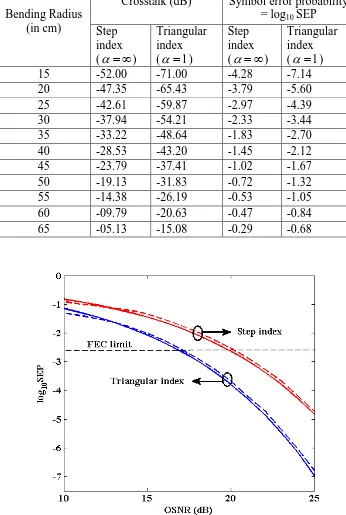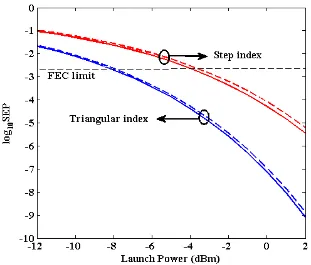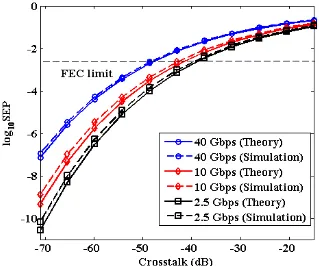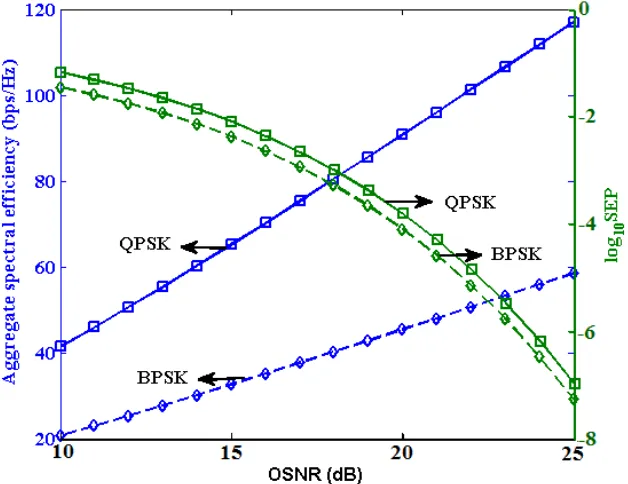City, University of London Institutional Repository
Citation
:
Mishra, J. K., Priye, V. & Rahman, B. M. (2016). Augmenting data rate performance for higher order modulation in triangular index profile multicore fiberinterconnect. Optics Communications, 371, pp. 40-46. doi: 10.1016/j.optcom.2016.03.038
This is the accepted version of the paper.
This version of the publication may differ from the final published
version.
Permanent repository link:
http://openaccess.city.ac.uk/16560/Link to published version
:
http://dx.doi.org/10.1016/j.optcom.2016.03.038Copyright and reuse:
City Research Online aims to make research
outputs of City, University of London available to a wider audience.
Copyright and Moral Rights remain with the author(s) and/or copyright
holders. URLs from City Research Online may be freely distributed and
linked to.
1
Augmenting Data Rate Performance for Higher order Modulation
in Triangular Index Profile Multicore Fiber Interconnect
Jitendra K. Mishra1,*, Vishnu Priye1, and B. M. A. Rahman2
1Department of Electronics Engineering, Indian School of Mines Dhanbad, 826004, India 2Department of Electrical and Electronic Engineering, City University London, London EC1V 0HB,
UK
*Corresponding author: jkmishra.ism@gmail.com
Abstract
A triangular profile multicore fiber (MCF) optical interconnect (OI) is investigated to augment
performance that typically degrades at high data rates for higher order modulation in a short
reach transmission system. Firstly, probability density functions (PDFs) variation with inter–core
crosstalk is calculated for 8–core MCF OI with different index profile in the core and it was
observed that the triangular profile MCF OI is the most crosstalk tolerant. Next, symbol error
probability (SEP) for higher order quadrature phase shift keying (QPSK) modulated signal due to
inter–core crosstalk is analytically obtained and their dependence on typical characteristic
parameters are examined. Further, numerical simulations are carried out to compare the error
performance of QPSK for step index and triangular index MCF OI by generating eye diagram at
40 Gbps per channel. Finally, it is shown that MCF OI with triangular index profile supporting
QPSK has double spectral efficiency with tolerable trade off in SEP as compared with those of
binary phase shift keying (BPSK) at high data rates which is scalable up to 5 Tbps.
Keywords
:
Optical interconnects; symbol error probability; multicore fibers; crosstalk.1.
Introduction
To keep pace with tremendous increase in data volume requirement and to overcome bandwidth
density drives, optical interconnect (OI) is fast becoming a viable solution to support futuristic
data centers, high performance computers, and emerging on–chip integrated photonic systems
[1]. Fiber ribbon or individual standard single mode fiber based interconnection technology is on
the verge of fundamental limit and is struggling to cope with steadily growing demand for
bandwidth in next generation rack-to-rack, board-to-board, box-to-box and chip-to-chip
interconnect applications [2]. Space division multiplexing (SDM) has recently attracted attention
2
transmission system [3]. The key issues for design of the forthcoming heterogeneous and
bandwidth intensive OI are high fiber count and high density cable with minimum escalation in
link cost and power budget [4, 5]. The SDM technology based on multicore fibers (MCFs) has
potential to thrust the data traffic capacity up to an unprecedented level [6]. Recently, with
short-range MCF OIs an aggregate data transmission capacity of 240 Gbps has experimentally been
achieved in a multichannel transmission using low-cost vertical cavity surface emitting lasers
[7]. Furthermore, it has been recently reported that, although hexagonal configurations of cores
in MCF are more closely packed but are not well suited to number of parallel lanes in data buses
required in computers as well as in integrated silicon photonic transceivers [8]. For such specific
applications, rectangular array of 8–core MCF has been recently proposed for future exaflop
(1018) high performance computing systems [8, 9].
MCF with SDM, not only increases system capacity but is also less vulnerable to limits
imposed by fiber non-linearity as it guides less power per core [6]. However, one of the most
critical issues impending efficient usage of MCF as OI, is core crosstalk [10-13]. The
inter-core crosstalk inevitably occurs due to the mode coupling between the adjacent inter-cores, and as a
consequence limits the transmission performance of ultra-short and short-reach optical
interconnects. In this context, effect of inter-core crosstalk on the symbol-error probability (SEP)
performance of multi-level modulation formats has assumed great importance as it is being
speculated that multi-level modulation along with SDM in MCF can overcome bandwidth
density drives of big-data era [14]. Recently, an experimental work has been reported that
demonstrates the impact of quadrature phase-shift keying (QPSK) and quadrature amplitude
modulation (QAM) for long distance transmission using hexagonal 7-core MCF [15]. In short
reach OI system, MCF combined with spectral efficient higher order modulation format is
considered as an alternate efficient method to increase the transmission capacity provided
crosstalk tolerance is decreased concurrently [16]. On-off keying (OOK) is the only modulation
and main source of interest for short reach commercial links today, since they are sufficiently
low cost with low power consumption [17]. However, to realize spectrally efficient short reach
optical transmission, various modulation formats, such as quadrature amplitude modulation in
combination with sub-carrier modulation [18], carrier-less amplitude/phase modulation [19],
pulse amplitude modulation [20], poly-binary modulation and discrete multi-tone modulation
3
single mode fiber (SSMF) that cannot cope with future bandwidth hungry services required in
data centers, core routers, terabit switches, high performance computers and digital cross connect
systems. On the other hand, MCF based short reach OI communication system using binary
phase shift keying (BPSK) modulation format has been recently reported as an effective solution,
but may not be enough to exploit huge optoelectronic bandwidth disparity existing between
requirement and availability in forthcoming era of big data and high speed internet traffic [21].
In this paper, transmission of higher order QPSK modulation in index profiled MCF based
short reach OI system is investigated. First, probability density function is statistically obtained
for crosstalk variance in MCF having different index parameter α. Based on the distribution,
MCF OI with α = 1 is selected for further study. Next, mathematical expressions for symbol
error probability in QPSK modulated SDM system using MCF is derived with a view to apply in
short reach OI communication systems. The effect of the inter-core crosstalk on SEP
performance is investigated for rectangular arrayed 8-core MCF with triangular (α =1) refractive
index profile [9] for various parameters. Next, a simulation experiment is carried out in Rsoft
OptSim that compares performances of binary phase shift keying (BPSK) and QPSK in step
index MCF OI through eye diagram. Lastly, the same experiment is repeated for QPSK in
triangular index profile MCF OI. Throughout the paper, conventional definition of index profiled
refractive index n r( )nc
1 2
r a/
in individual cores of MCF is followed. Here n(r) is refractive index at a radial distance r from center of the core, a is the core radius, nc is therefractive index of the core at r=0, ncl is homogeneous (i.e. n(r) = ncl forra) refractive index of the cladding, Δ represents relative refractive index difference between core and cladding and α
defines the shape of the profile.
2.
Theoretical Expression for Symbol Error Probability
Stochastic variation of crosstalk (XT) in a MCF is identified as major impeding factor which
fluctuates predominantly at phase matching points by scant random perturbations of various
internal and external factors, such as bends and twists [11]. The probability density function of
the crosstalk distribution is represented as [11]
4 2
(
4 2
) T exp T
T
X X
f X
4
here, 2
represents variance of normally distributed in-phase and quadrature components of
polarization modes of the coupled power. The individual cores are of diameter 7.8, 7.0, 6.6 and
5.0 μm for different index profile, 1, 2, 3 and respectively. The relative refractive index
difference Δ for different index profile 1, 2, 3 and in 8-core MCF OI are 1.04, 0.88, 0.85
and 0.80 % respectively with a mode field diameter of 6.76 μm. The core separation within a row
is 50 μm and the two rows are separated by 100 μm which is twice the core-to-core spacing
within a row. Other parameters, such as, fiber length and cladding refractive index is assumed to
be, 100 m and 1.45 respectively, at the operating wavelength of 1.55 μm [9]. The crosstalk
between adjacent cores is calculated by using the coupled power theory [12]. Analytical
approach based on exponential autocorrelation function is used to realize accurate estimation of
inter-core crosstalk in the non-phase-matching region of MCF [12]. The power coupling
coefficient for exponential autocorrelation is written as [12]
2 2
2
1 ( )
mn c mn
mn c
K d h
d
(2)
where m, n represent the core m and n, Kmn is the average mode coupling coefficient between
these two cores, dc is the correlation length and Δβmn is the propagation constant difference
[image:5.612.100.516.454.559.2]between the cores m and n.
Fig. 1. The schematic of distributed optical power coupling in a MCF with correlation length dc.
In order to consider the distributed crosstalk in bend-induced randomly perturbed MCF, it is
divided into finite segment of correlation length dc,as shown in Fig. 1. The average value of
inter-core crosstalk with dc= 0.05 m agree well with the measurement results [13] and therefore,
5
coupling coefficient hmn and coupled power theory, the crosstalk between two α index profile
cores of MCF over a length L is expressed as [12]
XT tanh(h Lmn ) (3) Probability density functions (PDFs) for statistical crosstalk distribution in 8-core MCF OI for
different index profiles are calculated from Eq. (1) and depicted in Fig. 2. The distribution of
PDF shows that inter-core crosstalk can be considered as virtual additive white Gaussian noise
[image:6.612.163.456.246.491.2](VAWGN).
Fig. 2. Crosstalk distributions for different index profile α in 8-core MCF.
In BPSK system, the coordinates of the transmitted signal pair can be written as E and
E
to represent bits '0' and '1', respectively, where, E = Eb represents the transmitted signal
energy per bit. To focus only on impact of inter-core crosstalk in MCF OI short reach
communication system, the signal received at the receiver when bit '0' is transmitted can be
written as [22, 23],
y Eb XT (4)
where, XT is the crosstalk between the adjacent cores and considered as VAWGN. From (1),
6
4 2
(1 0) exp
4 2
T
b b
X
y E y E
P dy
(5)where, XTμ is the mean value of the crosstalk distribution. After solving the integral of Eq. (5),
the conditional error probability at the receiver is obtained as [21]
2 2
(1 0) 3 exp 2
2 2 b b E E P (6)
Similarly, due to symmetry of BPSK signal constellation, the conditional error probability when
bit '1' is transmitted can be expressed as P(0/1) = P(1/0) [22, 23]. Since, '0' and '1' are equally
probable to occur at the input of MCF interconnects transmission system, the bit error probability
(BEP) or equivalently SEP for coherent BPSK system is expressed as [21]
1 1
1 0 0 1
2 2
eb
P P P
3 4 exp 2 4
4 4 b b E E
(7)
Furthermore, the probability of symbol error for the coherent QPSK system is [22, 23]
Peq 1 Pc (8)
where, Pc is probability that the symbol is received correctly. The coherent QPSK system can be
consider as two coherent BPSK systems in parallel with phase quadrature carriers. Therefore, for
coherent QPSK system the signal energy per bit is E = Eb /2.
Thus, Pccan be given as
2 2
4 4
1 1 3 exp 2
8 8 b b c eb E E P P (9)
Substituting (9) in (8), Peqis obtained as
4 4 4 4 4
6 2 exp 2 9 6 exp 2 2
8 8 8 8 8
b b b b b
eq
E E E E E
P
(10)
Equations (7) and (10) are used to estimate SEP for BPSK and higher order QPSK by evaluating
7
3.
Simulation setup of MCF interconnects transmission
Simulation setup on Rsoft OptSim platform for QPSK modulated SDM MCF interconnects
transmission system is shown in Fig. 3(a) [21]. Each polarization multiplexed transmitter block
consists of individual transmitters configured using two nested Mach-Zehnder modulators.
Blocks are used that can generate non return-to-zero (NRZ) modulation and parameters set for
eight channels of 10 Gbaud QPSK signals with channel spacing of 50 GHz. Further, each
channel is shaped by a fourth order super Gaussian optical filter having 3 dB bandwidth of
45GHz (i.e. 90% of channel spacing) to suppress spectral side lobes and minimize influence of
the inter-channel crosstalk. Continuous wave optical source at 1550 nm is tuned to give 100 kHz
linewidth optical carrier which is fed into an integrated modulator. In modulator pseudo-random
bit sequence (PRBS) of period 215 −1 is selected to modulate the phase of the optical carrier [21].
Fig. 3(a) Simulation setup for QPSK modulated short reach transmission system using 8-core MCF. TX: transmitter, RX: receiver, MUX: multiplexer, DEMUX: demultiplexer.
The transmission block is connected to 8:1 wavelength division multiplexer (WDM) through
which combined NRZ QPSK optical signal can be launched into MCF OI module that consists of
rectangular arrayed with eight α index profile identical cores and is shown in inset of Fig. 3(b).
The MCF has two linear rows with each row having of 4 cores. The parameters for step index
profile ( ) and triangular index profile (1) MCF are same as that in Fig. 2, at the
operating wavelength of 1.55 μm. The equivalent functional module that replicates the
[image:8.612.110.497.322.487.2]8
is shown in Fig. 3(b) [21]. In the equivalent module, the modulated QPSK signal is splitted into
eight channels representing 8 cores of MCF having optical transmission of 100 m of SSMF [21].
Fig. 3(b). Equivalent simulation model of 8-core MCF OI. The schematic of rectangular array 8-core MCF with triangular index profile is shown in inset [8, 9].
In order to obtain mode coupling coefficient between adjacent cores, firstly electric field
distribution of MCF is calculated using commercial finite element analysis software FemSIM
[9]. Key issue of inter-core crosstalk in MCF interconnects transmission system is evaluated in
absence of nonlinear noise as MCF is less sensitive to fiber nonlinearities [6]. Crosstalk in any
core ‘A’ is defined as the ratio of crosstalk power leaking into ‘A’ from adjacent core to the
signal power guided in core ‘A’. Crosstalk among cores that are in different rows are minimal
due to larger separation and are ignored [9]. The distributed crosstalk powers between
neighboring cores (see Fig. 1) over a length 100 m is calculated by coupled power theory [12].
First, the power coupling coefficient is obtained for correlation length dc and then integrated over
total length L. Next, an exact coupling ratio is estimated between two α index profile cores of
MCF, which is equivalent to cumulative crosstalk over a length L (100 m). In the equivalent
module, eight cores vulnerable to crosstalk are represented by eight SSMF with couplers. In
[image:9.612.140.472.137.396.2]9
power ratio is assigned to optical coupler in the module of Fig. 3(b) and all are ultimately
combined though optical combiner to give a single output [21].
The WDM output of MCF OI is amplified by 25 dB fixed gain optical amplifier with a Noise
Figure of 4.5 dB and then demultiplexed [21]. In the receiver block, optical filter identical to
the one in transmitter is used to remove noise power outside the signal bandwidth. The
photodetector inside the receiver block converts the received optical QPSK signal into electrical
equivalent QPSK signal, which is further subjected to a 4th order Bessel low pass filter. The
filtered signals are sampled at two samples per symbol by a finite impulse response (FIR) filter.
The pre-convergence is processed by an equalizer containing 15 tap FIR filters driven by
constant modulus algorithm (CMA) [24], having coefficients adjusted through decision directed
least mean squares (DD-LMS) method that finally provides the required numerical value of
symbol error probability.
4.
Results and Discussion
Figure 2, apart from establishing VAWGN properties of inter–core crosstalk for cores with
different index profiles , also reveals that probability density function has higher peak and
narrower distribution as value of α is decreased. It is inferred from the figure that for triangular
index profile ( = 1), samples of probability distribution are close to mean value of crosstalk,
which promises better and crosstalk tolerant response of digital receivers in short reach signal
transmission system using MCF OI.
To further investigate the crosstalk tolerance of triangular index profile MCF, different
configurations are considered that can occur while fabrication of MCFs or during their usage as
interconnects. While fabrication separation between cores can alter and during application as
interconnects it may have to undergo bends. In both the cases crosstalk between cores of MCF
will change resulting in variation in SEP. Here, considering the practical situation, different
configurations are considered that depend on bending radii varying from 15 – 65 cm in steps of 5
cm. Table I lists crosstalk and SEP calculated for QPSK modulated short reach OI transmission
system for step index and triangular index cores of MCF with bending radius. It can be inferred
10
triangular index profile MCF is more tolerant to crosstalk than that of step index MCF resulting
[image:11.612.126.486.139.385.2]in lower SEP.
Table I. Crosstalk and SEP comparison for triangular and step index profile MCF OI
Bending Radius (in cm)
Crosstalk (dB) Symbol error probability = log10 SEP
Step index (
)Triangular index (1)
Step index (
)Triangular index ( 1) 15 -52.00 -71.00 -4.28 -7.14 20 -47.35 -65.43 -3.79 -5.60 25 -42.61 -59.87 -2.97 -4.39 30 -37.94 -54.21 -2.33 -3.44 35 -33.22 -48.64 -1.83 -2.70 40 -28.53 -43.20 -1.45 -2.12 45 -23.79 -37.41 -1.02 -1.67 50 -19.13 -31.83 -0.72 -1.32 55 -14.38 -26.19 -0.53 -1.05 60 -09.79 -20.63 -0.47 -0.84 65 -05.13 -15.08 -0.29 -0.68
[image:11.612.130.476.146.661.2]11
A triangular index profile MCF can be suitable in a short reach communication system
supporting higher order QPSK, if symbol error probability performance shows remarkable
improvement. In this regard, SEP is calculated for different OSNR and input launched power for
40 Gbps per channel. Figure 4 shows that for a given OSNR, SEP decreases for triangular profile
as compared to that of step index. Forward error correction (FEC) limit [25] defining threshold
sensitivity level of a QPSK receiver reduces by about 3 dB when triangular profile MCF is used
establishing better receiver performance. Further, SEP predicted by theory of Section 2 and
simulation experiment of Section 3 agree well for both step index and triangular index MCF. It is
worth noting that for a given error probability, maximum discrepancy between theory and
[image:12.612.151.462.302.567.2]simulation is about 0.3 dB in OSNR for both step index and triangular index MCF OI.
Fig. 5. SEP as a function of launch power for QPSK modulated system in step index and triangular index MCF OI. Solid curves are obtained from theory of Section 2 and dashed curves from simulation experiment of Section 3.
Figure 5 illustrates the error probability performance of 100 m long 8-core QPSK modulated
OI transmission system as a function of launch power at 40 Gbps per channel. It can be seen
from intersection point of FEC limit and SEP that sensitivity of a digital receiver reduces from –
12
simulation experiment results for both the cases are in good agreement as well. For step index
MCF an error less than 3.5% is observed and agrees within 1% for triangular index MCF OI at
40 Gbps. The discrepancy between the error probability values is sufficiently small, which
[image:13.612.147.466.185.451.2]proves the feasibility of simulation module for MCF OI transmission system.
Fig. 6. SEP as a function of inter-core crosstalk for various QPSK modulated Signal.
For triangular profile MCF and various data rates used in optical communication, error
probability performances for different configurations both calculated and simulated at 0 dBm
launch power are given in Table I. It can be seen from Fig. 6, inter-core crosstalk degrades the
error performance by increasing the value of SEP at all data rates. Moreover, for a given
crosstalk, the maximum degradation is for 40 Gbps per channel. It suggests that high data rate
short reach transmission has relatively low tolerance to crosstalk. From Fig. 6, it can be inferred
that for 40 Gbps per channel, sensitivity is −48.27 dB at the FEC threshold of SEP while it
increases to −43.21 dB at 10 Gbps per channel and −39.13 dB at 2.5 Gbps per channel. Hence, to
achieve high speed and lower cost per bit in practical short reach interconnects transmission and
high performance computing applications data rate of 40 Gbps per channel is viable if crosstalk
13
6] are almost identical. However, at data rates of 2.5 Gbps and 10 Gbps, for a given error
probability, discrepancy between theory and simulation is less than −0.8 dB which is small
14 Figs. 7. Eye diagrams of (a) BPSK and (b) QPSK signal for step index MCF and (c) Eye diagram of QPSK signal
for triangular index MCF.
Experiment is carried on using Rsoft OptSim simulator to measure eye patterns for short
reach transmission system consisting of step index and triangular index MCF. First, for step
index MCF transmission, eye pattern is measured for BPSK and higher order QPSK modulated
signals. Next, experiment is repeated for QPSK after replacing the step index MCF with a
triangular index one. The measured eye patterns and related parameters are shown in Fig. 7 and
[image:15.612.87.527.576.697.2]Table II respectively.
Table II. Performance parameters measured from eye diagrams of Fig. 7.
Parameters BPSK( ) QPSK( ) QPSK( 1)
Eye width (in ns) 0.074 0.060 0.085
Distortion 2.6×10-5 20×10-4 2.4×10-6
Zero crossing time jitter (in ns) 0.008 0.022 0.01
Timing error sensitivity (in ns) 0.037 0.030 0.043
15
From Fig. 7 and Table II, it can be observed that for MCF with , higher order QPSK
has smaller eye width and higher distortion with respect to BPSK. In particular, it can be seen
from Fig. 7, there is strong inter-core crosstalk effects at the wave transition points and sampling
points for QPSK signal with step index profile ( ). Thus for step index MCF, QPSK is not
an appropriate modulation format for transmission. However, from above Fig. 7 and Table II, it
can be observed that for QPSK communication system having triangular index core has widest
open area of eye pattern. A more open eye pattern corresponds to minimal inter-core crosstalk
distortion and better OSNR performance of QPSK modulated MCF OI short reach
communication. Although slope for sensitivity to timing error and zero crossing jitter are low for
BPSK signal at , inter-core crosstalk distortion for QPSK signal at 1is 2.4×10-6 which
is one order lower to that of BPSK (2.6×10-5) with step index profile core.
Finally, aggregate spectral efficiency which is product of number of cores and spectral
efficiency per core is calculated. Its variation with respect to OSNR for BPSK and QPSK short
reach MCF OI communication system having step index core ( ) and triangular index core
( 1) MCF OI respectively is plotted in Fig. 8. It is observed that aggregate spectral efficiency
[image:16.612.150.464.420.662.2]of QPSK short reach MCF OI system having triangular index core is twice at all values of OSNR
16
as compared to BPSK modulated system having step index MCF. In Fig. 8, SEP as a function of
OSNR for the two cases is also plotted. It shows that error probability of QPSK short reach
communication system even with triangular index core (1) MCF is slightly (0.3 dB) higher
than BPSK transmission system with step index core. This marginal increase in symbol error
probability can be traded off with two-fold gain in aggregate spectral efficiency. Figure 8 also
reveals that the capacity of a MCF based short reach OI system can be increased eight fold with
SEP~10 −7 for 40 Gbps per channel at inter–core crosstalk of −71 dB. Overall capacity of QPSK
modulated 8-core MCF transmission can increase upto 5 Tbps (8 cores × 8 λ × 2×40 Gbps)
which is much higher than data rates reported till now [7, 19-21].
5.
Conclusion
Although BPSK systems has advantage of minimum escalation in link cost and power budget,
higher order QPSK modulation scheme for OI application is explored to meet ever increasing
bandwidth requirement. QPSK requires half bandwidth compared to BPSK modulation, which
can be subsequently exploited to meet high capacity transmission demands of next generation
short reach MCF interconnects. However, higher order modulation is more susceptible to
inter-core crosstalk, and inevitably degrades the error probability performance of MCF interconnects
transmission. To overcome this issue, firstly, statistical crosstalk distribution of inter-core
crosstalk for 8-core MCF OI having different index profiles is investigated. It is observed that
triangular profile MCF OI may be most suitable for crosstalk tolerant communication. Next, a
closed-form error probability expression for QPSK modulated signal applicable to MCF
interconnects with inter-core crosstalk is analytically derived. The dependence of SEP on various
parameters such as OSNR, launch power, and inter-core crosstalk is investigated for both step
index and triangular index MCF OI supporting QPSK modulated data rate of 40 Gbps per
channel. An extensive numerical simulations have been carried out to verify the theoretical
predictions and are found to be in good agreement. Further, performances of BPSK and QPSK in
a short reach MCF OI based communication are investigated by simulating eye diagrams. It is
shown that crosstalk degradation in QPSK modulated step index MCF OI system can be
drastically improved by using a triangular index MCF OI. Present results clearly substantiate that
inter-core crosstalk distortion for QPSK signal at 1is 2.4×10-6 which is one order lower than
17
probability performance for QPSK modulated triangular index MCF interconnects transmission
is traded off with two-fold gain in aggregate spectral efficiency. These results offer a framework
to augment the transmission capacity up to 5 Tbps for MCF based practical short reach
communication system and silicon photonic transceivers.
Acknowledgement
Authors (JKM and VP) who are currently at City University, London, UK under AREAS+
Erasmus Mundus mobility, acknowledge the financial support from European Commission.
References
[1] M. A. Taubenblatt, Optical interconnects for high–performance computing, J. Lightwave
Technol. 30 (2012) 448–457.
[2] S. Abrate, R. Gaudino, C. Zerna, B. Offenbeck, J. Vinogradov, J. Lambkin, A. Nocivelli,
10Gbps POF ribbon transmission for optical interconnects, in: proceeding of IEEE Photonics
Conference,2011, pp. 230–231.
[3] T. Morioka, New generation optical infrastructure technologies: EXAT initiative towards
2020 and beyond, in: proceeding of 14th OptoElectronics and Communications Conference,
2009, pp. 1–2.
[4] J. A. Kash, A. Benner, F. E. Doany, D. Kuchta, B. G. Lee, P. Pepeljugoski, L. Schares, C.
Schow, M. Taubenblatt, Optical interconnects in future servers, in: Optical Fiber
Communication Conference and Exposition (OFC/NFOEC), 2011 and the National Fiber
Optic Engineers Conference, 2011, pp. 1–3.
[5] C. Kachris, K. Kanonakis, I. Tomkos, Optical interconnection networks in data centers:
recent trends and future challenges,IEEE Commun. Mag. 51 (2013) 39–45.
[6] T. Morioka, Y. Awaji, R. Ryf, P. Winzer, D. Richardson, F. Poletti, Enhancing optical
communications with brand new fibers, IEEE Commun. Mag. 50 (2012) s31–s42.
[7] P. Westbergh, J. S. Gustavsson, A. Larsson, VCSEL arrays for multicore fiber interconnects
with an aggregate capacity of 240 Gb/s, IEEE Photon. Technol. Lett. 27 (2015) 296–299.
[8] D. L. Butler, M. J. Li, S. Li, K. I. Matthews, V. N. Nazarov, A. Koklyushkin, R. L.
18
density, short reach optical links, in: proceeding of IEEE Optical Interconnects Conference,
2013, pp. 9–10.
[9] J. K. Mishra, V. Priye, Design of low crosstalk and bend insensitive optical interconnect
using rectangular array multicore fiber, Opt. Commun. 331 (2014) 272–277.
[10]T. Hayashi, T. Nagashima, O. Shimakawa, T. Sasaki, E. Sasaoka, Crosstalk variation of
multi–core fibre due to fibre bend, in: Proceedings of 36th European Conference and
Exhibition on Optical Communication,2010, pp. 1–3.
[11]T. Hayashi, T. Taru, O. Shimakawa, T. Sasaki, E. Sasaoka, Design and fabrication of
ultralow crosstalk and low–loss multi–core fiber, Opt. Express 19 (2011) 16576–16592.
[12]M. Koshiba, K. Saitoh, K. Takenaga, S. Matsuo, Analytical expression of average
power-coupling coefficients for estimating intercore crosstalk in multicore fibers, IEEE Photon. J. 4
(2012) 1987–1995.
[13]S. Matsuo, K. Takenaga, Y. Arakawa, Y. Sasaki, S. Tanigawa, K. Saitoh, M. Koshiba,
Crosstalk behavior of cores in multi–core fiber under bent condition, IEICE Electron. Exp. 8
(2011) 385–390.
[14]T. A. Eriksson, B. J. Puttnam, R. S. Luís, M. Karlsson, P. A. Andrekson, Y. Awaji, N.
Wada, Experimental investigation of crosstalk penalties in multicore fiber transmission
systems, IEEE Photon J. 7 (2015) 7200507.
[15]B. J. Puttnam, T. A. Eriksson, J.-M. D. Mendinueta, R. S. Luís, Y. Awaji, N. Wada, M.
Karlsson, E. Agrell, Modulation formats for multi-core fiber transmission, Opt. Express 22
(2014) 32457–32469.
[16]J. H. Chang, H. G. Choi, Y. C. Chung, Achievable capacity improvement by using multi-
level modulation format in trench-assisted multi-core fiber system, Opt. Express 21 (2013)
14262–14271.
[17]J. Lee, N. Kaneda, T. Pfau, A. Konczykowska, F. Jorge, J.-Y. Dupuy, Y.-K. Chen, Serial
103.125-Gb/s transmission over 1 km SSMF for low-cost, short-reach optical interconnects,
in: Optical Fiber Communication Conference and Exposition (OFC) 2014, pp. 1–3.
[18]J. Tang, J. He, D. Li, M. Chen, L. Chen, 64/128-QAM Half-cycle subcarrier modulation for
19
[19]K. Zhong, X. Zhou, T. Gui, L. Tao,Y. Gao, W. Chen, J. Man, L. Zeng,A. P. T. Lau, C. Lu,
Experimental study of PAM-4, CAP-16, and DMT for 100 Gb/s short reach Optical
transmission systems, Opt. Express 23 (2015) 1176–1189.
[20]X. Xu, E. Zhou, G. N. Liu, T. Zuo, Q. Zhong, L. Zhang,Y. Bao, X. Zhang, J. Li , Z. Li,
Advanced modulation formats for 400-Gbps short-reach optical inter-connection, Opt.
Express 23 (2015) 492–500.
[21]J. K. Mishra, V. Priye, B. M. A. Rahman, Error probability performance of a short-reach
multicore fiber optical interconnect transmission system, Opt. Lett. 40 (2015) 4556–4559.
[22]J. G. Proakis, Digital Communications, fourth ed., McGraw-Hill, New York, 2001.
[23]S. Haykin, Communication Systems, fourth ed., Wiley, New York, 2001.
[24]S. Savory, Digital filters for coherent optical receivers, Opt. Express 16 (2008) 804–817.
[25]S. N. Shahi, S. Kumar, "A multi-core or multi-fiber WDM system," Opt. Commun. 294,

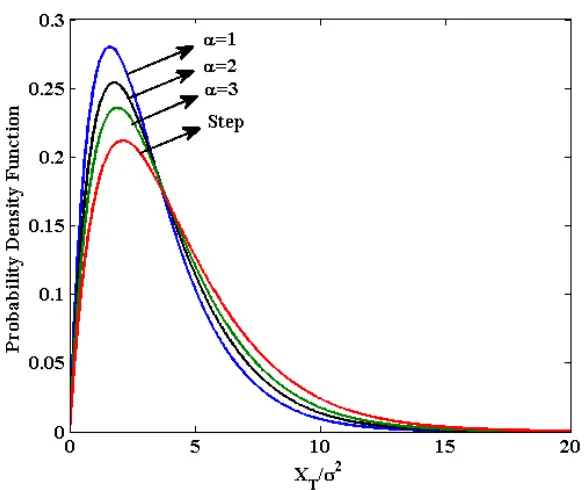
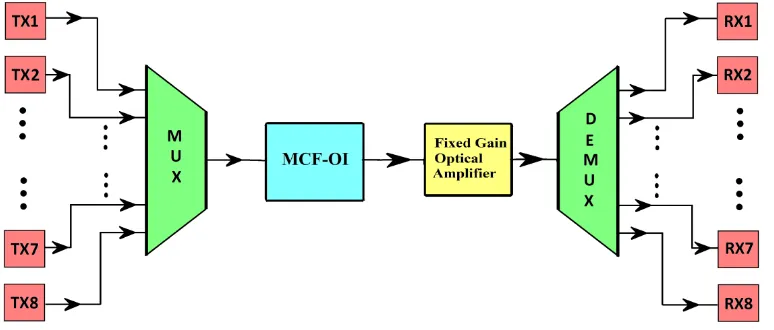
![Fig. 3(b). Equivalent simulation model of 8-core MCF OI. The schematic of rectangular array 8-core MCF with triangular index profile is shown in inset [8, 9]](https://thumb-us.123doks.com/thumbv2/123dok_us/1454229.98073/9.612.140.472.137.396/equivalent-simulation-model-schematic-rectangular-triangular-profile-inset.webp)
